Calcium or Sodium Carbonate Influence on Calcium Sulfoaluminate Clinker Hydration
Abstract
1. Introduction
2. Results and Discussion
2.1. Isothermal Conduction Calorimetry
2.2. Mechanical Strength
2.3. Paste Characterization
3. Materials and Methods
3.1. Materials
3.2. Methods
4. Conclusions
- The presence of CaCO3 does not significantly affect the hydration kinetics of KCSA, which behaves similarly to the reference with both 5% and 20% CaCO3, this behaviour being mainly related to a filler effect. The mechanical strength values increase progressively with hydration time and exceed those of the reference system after 90 days. The reaction products formed are those normally observed in the hydration of KCSA, ettringite, AH3 and, to a lesser extent, CAH10. However, a certain degree of carbonation of ettringite is observed over time, leading to the formation of calcite, gypsum and alumina gel, which densify the matrix and increase strength. These results suggest that the incorporation of CaCO3 (possibly as limestone) may have a beneficial effect on the development of the mechanical strength of KCSA.
- The presence of Na2CO3 has a negative effect on the hydration kinetics of KCSA, especially at low concentrations. The mechanical strengths are lower than those obtained with the reference. The amount of carbonate added also influences the reaction products formed. At low proportions, there is a long delay in the formation and precipitation of ettringite (similar to the behaviour observed in the hydration of KCSA with 1 M NaOH). The initial strengths are very low, but increase at 28 and 90 days due to the formation of ettringite and AH3. At longer ages, some carbonation is also observed to form calcite, thenardite and alumina gel.
- High levels of Na2CO3 (20%) initially inhibit the formation of ettringite and favour the formation of calcium aluminate, gaylusite and thenardite. When the sodium content is reduced, ettringite is formed (28 days), but as these are metastable reactions, the gaylusite and ettringite decompose to form calcite, alumina gel and a large amount of thenardite, which leaches out as efflorescence, causing microcracking and loss of strength in the material. These results indicate that the incorporation of Na2CO3 can have a detrimental effect on the mechanical strength development of KCSA.
Author Contributions
Funding
Institutional Review Board Statement
Informed Consent Statement
Data Availability Statement
Acknowledgments
Conflicts of Interest
References
- Sharp, J.H.; Lawrence, C.D.; Yang, R. Calcium sulfoaluminate cements—Low-energy cements, special cements or what? Adv. Cem. Res. 1999, 11, 3–13. [Google Scholar] [CrossRef]
- Zhang, F.P.; Glasser, L. Hydration of calcium sulfoaluminate cement at less than 24 h. Adv. Cem. Res. 2002, 14, 141–155. [Google Scholar] [CrossRef]
- Winnefeld, F.; Lothenbach, B. Hydration of calcium sulfoaluminate cements Experimental findings and thermodynamic modelling. Cem. Concr. Res. 2010, 40, 1239–1247. [Google Scholar] [CrossRef]
- Bullerjahn, F.; Boehm-Courjault, E.; Zajac, M.; Haha, M.B.; Scrivener, K. Hydration reactions and stages of clinker composed mainly of stoichiometric ye’elimite. Cem. Concr. Res. 2019, 116, 120–133. [Google Scholar] [CrossRef]
- Haha, M.B.; Winnefeld, F.; Pisch, A. Advances in understanding ye’elimite-rich cements. Cem. Concr. Res. 2019, 123, 105778. [Google Scholar] [CrossRef]
- Álvarez-Pinazo, G.; Cuesta, A.; García-Maté, M.; Santacruz, I.; Losilla, E.R.; Sanfélix, S.G.; Fauth, F.; Aranda, M.A.G.; De la Torre, A.G. In-situ early-age hydration study of sulfobelite cements by synchrotron powder diffraction. Cem. Concr. Res. 2014, 56, 12–19. [Google Scholar] [CrossRef]
- García-Maté, M.; De la Torre, A.G.; León-Reina, L.; Losilla, E.R.; Aranda, M.A.G.; Santacruz, I. Effect of calcium sulfate source on the hydration of calcium sulfoaluminate eco-cement. Cem. Concr. Compos. 2015, 55, 53–61. [Google Scholar] [CrossRef]
- Berger, S.; Coumes, C.C.D.; Le Bescop, P.; Damidot, D. Influence of a thermal cycle at early age on the hydration of calcium sulphoaluminate cements with variable gypsum contents. Cem. Concr. Res. 2011, 41, 149–160. [Google Scholar] [CrossRef]
- Júnior, L.U.D.T.; Rocha, J.C.; Cheriaf, M.; Padilla-Encinas, P.; Fernández-Jiménez, A.; Palomo, A. Effect of Alkaline Salts on Calcium Sulfoaluminate Cement Hydration. Molecules 2021, 26, 1938. [Google Scholar] [CrossRef]
- Padilla-Encinas, P.; Palomo, A.; Fernández-Jiménez, A. Effect of Na versus Ca Sulfate Salts on the Hydration of Calcium Sulfoaluminate Clinker. Molecules 2023, 28, 7651. [Google Scholar] [CrossRef]
- Lothenbach, B.; Le Saout, G.; Gallucci, E.; Scrivener, K. Influence of limestone on the hydration of Portland cements. Cem. Concr. Res. 2008, 38, 848–860. [Google Scholar] [CrossRef]
- Matschei, T.; Lothenbach, B.; Glasser, F.P. The role of calcium carbonate in cement hydration. Cem. Concr. Res. 2007, 37, 551–558. [Google Scholar] [CrossRef]
- Mounanga, P.; Khokhar, M.I.A.; El Hachem, R.; Loukili, A. Improvement of the early-age reactivity of fly ash and blast furnace slag cementitious systems using limestone filler. Mater. Struct. 2011, 44, 437–453. [Google Scholar] [CrossRef]
- Zajac, M.; Rossberg, A.; Le Saout, G.; Lothenbach, B. Influence of limestone and anhydrite on the hydration of Portland cements. Cem. Concr. Compos. 2014, 46, 99–108. [Google Scholar] [CrossRef]
- Schöler, A.; Lothenbach, B.; Winnefeld, F.; Zajac, M. Hydration of quaternary Portland cement blends containing blast-furnace slag, siliceous fly ash and limestone powder. Cem. Concr. Compos. 2015, 55, 374–382. [Google Scholar] [CrossRef]
- Ramezanianpour, A.M.; Hooton, R.D. A study on hydration, compressive strength, and porosity of Portland-limestone cement mixes containing SCMs. Cem. Concr. Compos. 2014, 51, 1–13. [Google Scholar] [CrossRef]
- McDonald, L.J.; Afzal, W.; Glasser, F.P. Evidence of scawtite and tilleyite formation at ambient conditions in hydrated Portland cement blended with freshly-precipitated nano-size calcium carbonate to reduce greenhouse gas emissions. J. Build. Eng. 2022, 48, 103906. [Google Scholar] [CrossRef]
- Berodier, E.; Scrivener, K. Understanding the Filler Effect on the Nucleation and Growth of C-S-H. J. Am. Cer. Soc. 2014, 97, 3764–3773. [Google Scholar] [CrossRef]
- Briki, Y.; Zajac, M.; Haha, M.B.; Scrivener, K. Impact of limestone fineness on cement hydration at early age. Cem. Concr. Res. 2021, 147, 106515. [Google Scholar] [CrossRef]
- Odler, I.; Schönfeld, R.; Dörr, H. On the combined effect of water soluble lignosulfonates and carbonates on portland cement and clinker pastes—II. Mode of action and structure of the hydration products. Cem. Concr. Res. 1978, 8, 525–538. [Google Scholar] [CrossRef]
- Janotka, I. Hydration of the cement paste with Na2CO3 addition. Ceram.-Silik. 2001, 45, 16–23. [Google Scholar]
- Sánchez-Herrero, M.J.; Fernández-Jiménez, A.; Palomo, A. C3S and C2S hydration in the presence of Na2CO3 and Na2SO4. J. Am. Ceram. Soc. 2017, 100, 3188–3198. [Google Scholar] [CrossRef]
- Sánchez-Herrero, M.J.; Fernández-Jiménez, A.; Palomo, A. Alkaline Hydration of Tricalcium Aluminate. J. Am. Ceram. Soc. 2012, 95, 3317–3324. [Google Scholar] [CrossRef]
- Martin, L.H.J.; Winnefeld, F.; Müller, C.J.; Lothenbach, B. Contribution of limestone to the hydration of calcium sulfoaluminate cement. Cem. Concr. Compos. 2015, 62, 204–211. [Google Scholar] [CrossRef]
- Xu, J.; Chen, J.; Lu, D.; Xu, Z.; Hooton, R.D. Effect of dolomite powder on the hydration and properties of calcium sulfoaluminate cements with different gypsum contents. Constr. Build. Mater. 2019, 225, 302–310. [Google Scholar] [CrossRef]
- Yeung, J.S.; Yam, M.C.; Wong, Y.L. Model for predicting shrinkage of concrete using calcium sulfoaluminate cement blended with OPC, PFA and GGBS. J. Build. Eng. 2020, 32, 101671. [Google Scholar] [CrossRef]
- Kim, N.; Seo, J.; Lee, H.K. Enhancement in clinker hydration degrees and later stage-ettringite stability of calcium sulfoaluminate cements by the incorporation of dolomite. Cem. Concr. Compos. 2025, 155, 105815. [Google Scholar] [CrossRef]
- Hargis, C.W.; Telesca, A.; Monteiro, P.J.M. Calcium sulfoaluminate (Ye’elimite) hydration in the presence of gypsum, calcite, and vaterite. Cem. Concr. Res. 2014, 65, 15–20. [Google Scholar] [CrossRef]
- Sánchez-Herrero, M.J.; Fernández-Jiménez, A.; Palomo, A. C4A3Š hydration in different alkaline media. Cem. Concr. Res. 2013, 46, 41–49. [Google Scholar] [CrossRef]
- Liu, Z.; Hou, L.; Deng, D.; de Schutter, G. The damage of calcium sulfoaluminate cement paste partially immersed in Na2CO3 solution. In Proceedings of the Second International Conference on Concrete Sustainability, Madrid, Spain, 13–15 June 2016; pp. 435–441. [Google Scholar]
- Winnefeld, F.; Barlag, S. Calorimetric and thermogravimetric study on the influence of calcium sulfate on the hydration of ye’elimite. J. Therm. Anal. Calorim. 2010, 101, 949–957. [Google Scholar] [CrossRef]
- Tang, S.W.; Zhu, H.G.; Li, Z.J.; Chen, E.; Shao, H.Y. Hydration stage identification and phase transformation of calcium sulfoaluminate cement at early age. Constr. Build. Mater. 2015, 75, 11–18. [Google Scholar] [CrossRef]
- Gao, X.; Yu, Q.L.; Brouwers, H.J.H. Properties of alkali activated slag-fly ash blends with limestone addition. Cem. Concr. Compos. 2015, 59, 119–128. [Google Scholar] [CrossRef]
- De Weerdt, K.; Haha, M.B.; Le Saout, G.; Kjellsen, K.O.; Justnes, H.; Lothenbach, B. Hydration mechanisms of ternary Portland cements containing limestone powder and fly ash. Cem. Concr. Res. 2011, 41, 279–291. [Google Scholar] [CrossRef]
- Zhang, Y.; Chang, J. Microstructural evolution of aluminum hydroxide gel during the hydration of calcium sulfoaluminate under different alkali concentrations. Constr. Build. Mater. 2018, 180, 655–664. [Google Scholar] [CrossRef]
- Padilla-Encinas, P.; Palomo, A.; Blanco-Varela, M.T.; Fernández-Jiménez, A. Calcium sulfoaluminate clinker hydration at different alkali concentrations. Cem. Concr. Res. 2020, 138, 106251. [Google Scholar] [CrossRef]
- Martinez-Ramirez, S.; Palomo, A. OPC hydration with highly alkaline solutions. Adv. Cem. Res. 2001, 13, 123–129. [Google Scholar] [CrossRef]
- Garcia-Lodeiro, I.; Fernandez-Jimenez, A.; Palomo, A. Hydration kinetics in hybrid binders: Early reaction stages. Cem. Concr. Compos. 2013, 39, 82–92. [Google Scholar] [CrossRef]
- Calos, N.J.; Kennard, C.H.L.; Whittaker, A.K.; Davis, R.L. Structure of Calcium Aluminate Sulfate Ca4Al6O16S. J. Solid State Chem. 1995, 119, 1–7. [Google Scholar] [CrossRef]
- Herrero, M.J.S. La Activación Alcalina Como Procedimiento para el Desarrollo de Nuevos Cementos Belíticos. Ph.D. Thesis, Universidad Nacional de Educación a Distancia, Madrid, Spain, 2017; p. 376. [Google Scholar]
- Chukanov, N.V. Infrared Spectra of Mineral Species; Springer: Berlin/Heidelberg, Germany, 2014. [Google Scholar] [CrossRef]
- Myneni, S.C.B.; Traina, S.J.; Waychunas, G.A.; Logan, T.J. Vibrational spectroscopy of functional group chemistry and arsenate coordination in ettringite. Geochim. Cosmochim. Acta 1998, 62, 3499–3514. [Google Scholar] [CrossRef]
- Vázquez-Moreno, T.; Blanco-Varela, M.T. Tabla de frecuencias y espectros de absorción infrarroja de compuestos relacionados con la química del cemento. Mater. Constr. 1981, 31, 31–48. [Google Scholar] [CrossRef]
- Fernández-Carrasco, L. Aplicación de la espectroscopia infrarroja al estudio de cemento aluminoso. Mater. Constr. 1996, 46, 39–51. [Google Scholar] [CrossRef]
- Fernández-Carrasco, L. Carbonatación de pastas de cemento de aluminato de calcio. Mater. Constr. 2001, 51, 127–136. [Google Scholar] [CrossRef]
- Huang, C.K.; Kerr, P.F. The Infrared Study of the Carbonate Minerals. Am. Mineral. 1960, 45, 311–324. [Google Scholar]
- Scrivener, K.; Snellings, R.; Lothenbach, B. (Eds.) A Practical Guide to Microstructural Analysis of Cementitious Materials; CRC Press: Boca Raton, FL, USA, 2016. [Google Scholar]
- Zhang, Y.; Chang, J.; Ji, J. AH3 phase in the hydration product system of AFt-AFm-AH3 in calcium sulfoaluminate cements: A microstructural study. Constr. Build. Mater. 2018, 167, 587–596. [Google Scholar] [CrossRef]
- Kharchenko, I.; Alekseev, V. Effect of ettringite morphology on the properties of expanding cement systems. E3S Web Conf. 2019, 110, 01037. [Google Scholar] [CrossRef]
- Grounds, T.; Midgley, H.G.; Novell, D.V. Carbonation of ettringite by atmospheric carbon dioxide. Thermochim. Acta 1988, 135, 347–352. [Google Scholar] [CrossRef]
- Park, J.; Seo, J.; Park, S.; Cho, A.; Lee, H.K. Phase profiling of carbonation-cured calcium sulfoaluminate cement. Cem. Concr. Res. 2025, 189, 107776. [Google Scholar] [CrossRef]

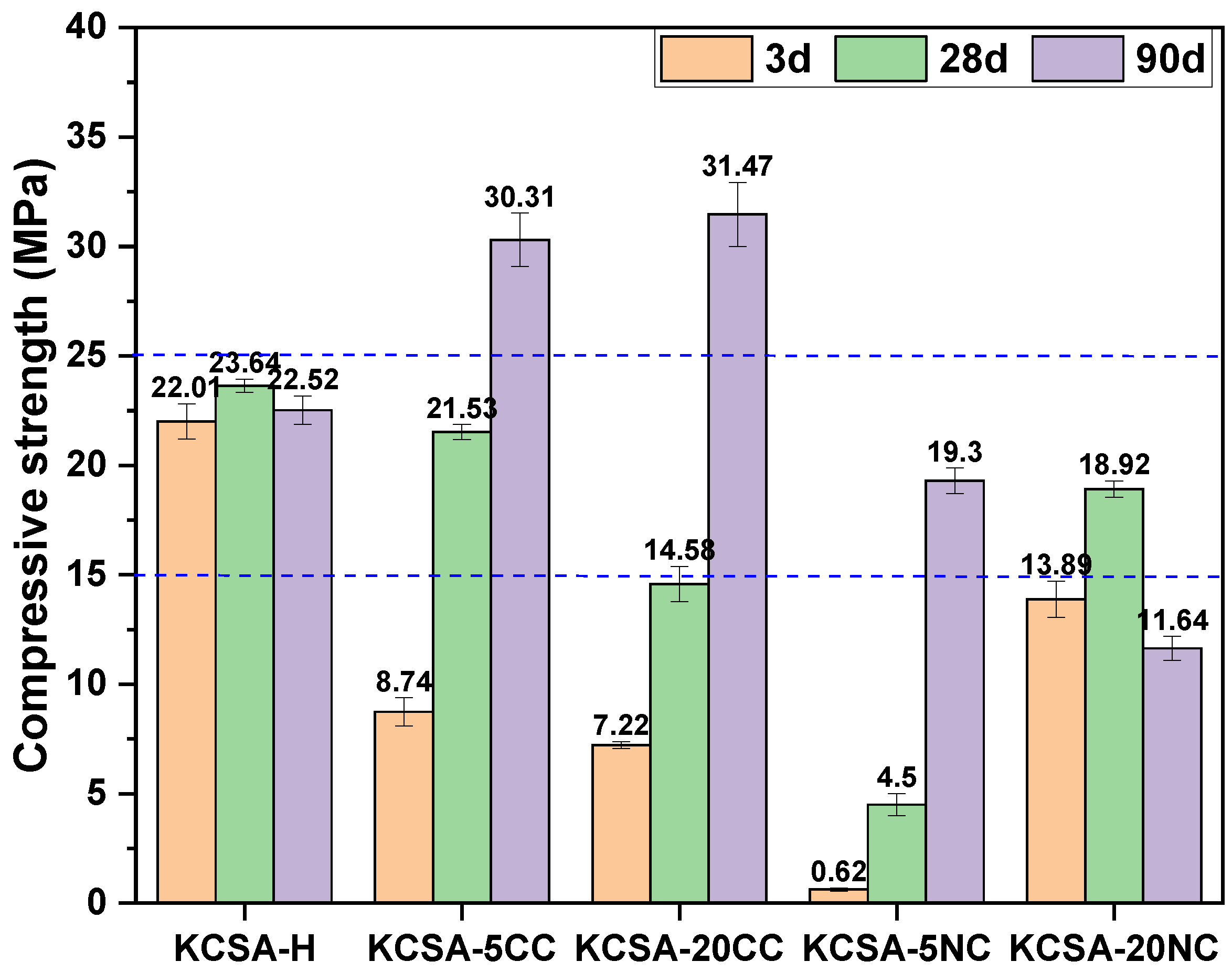
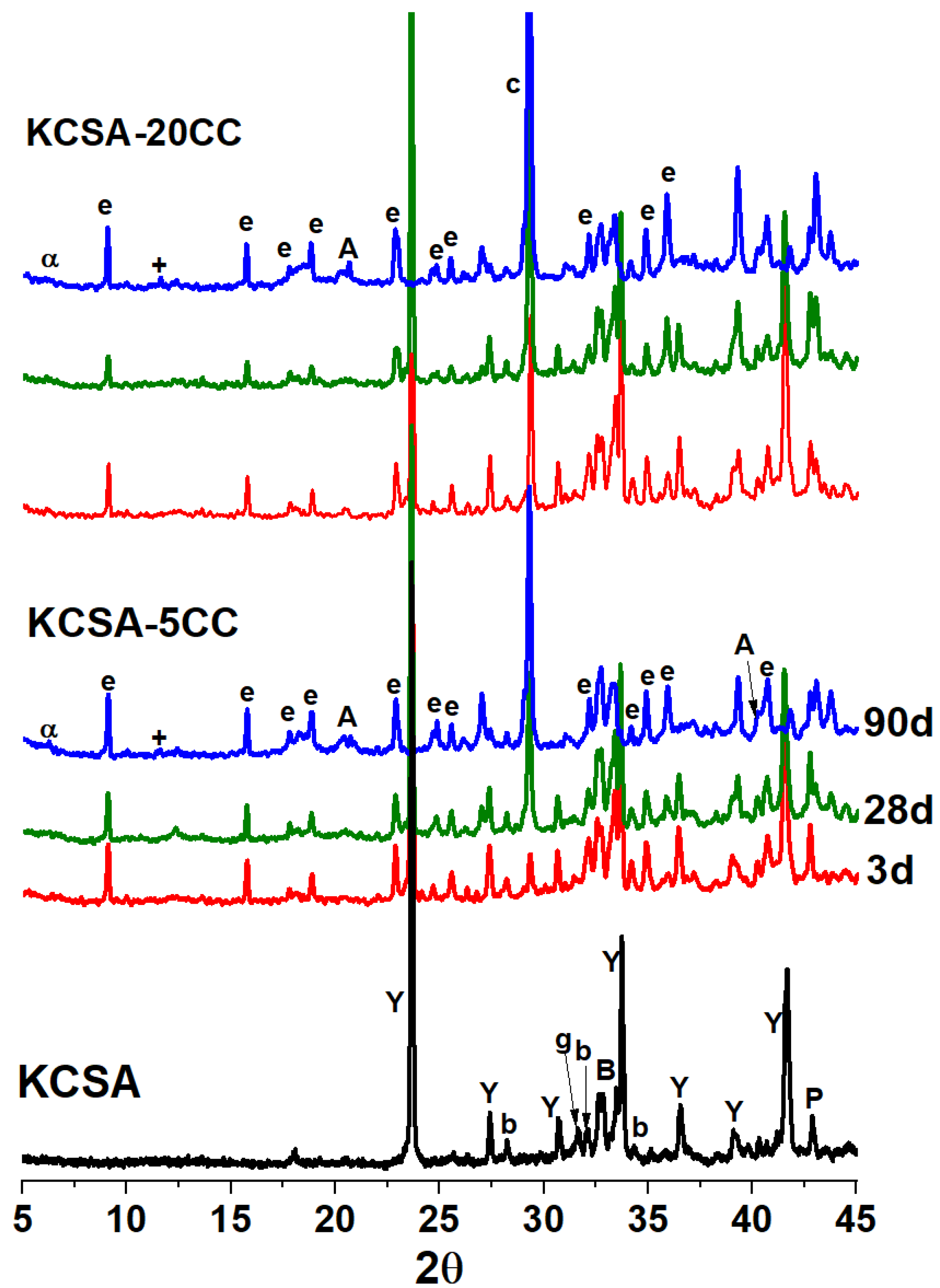


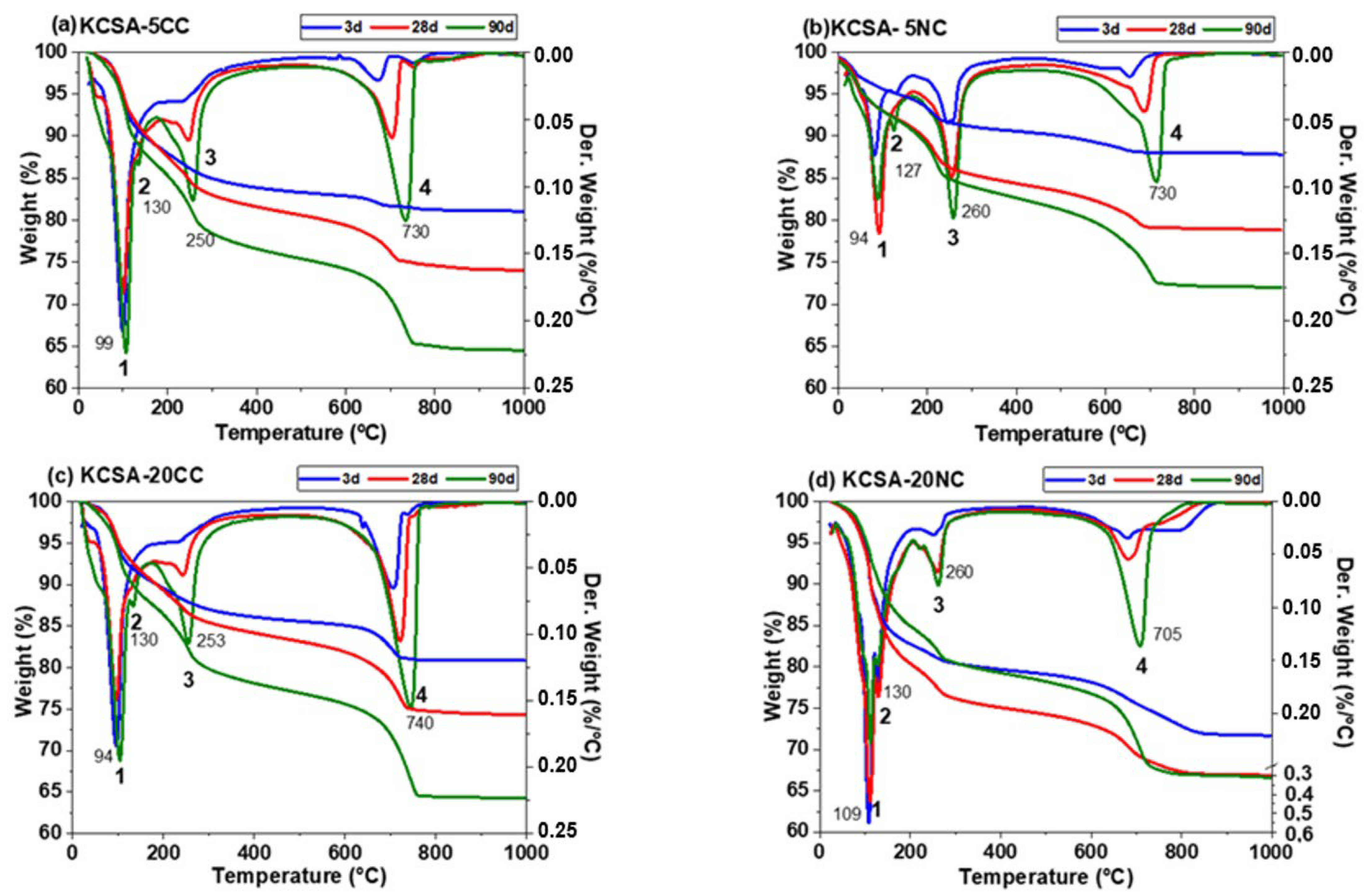
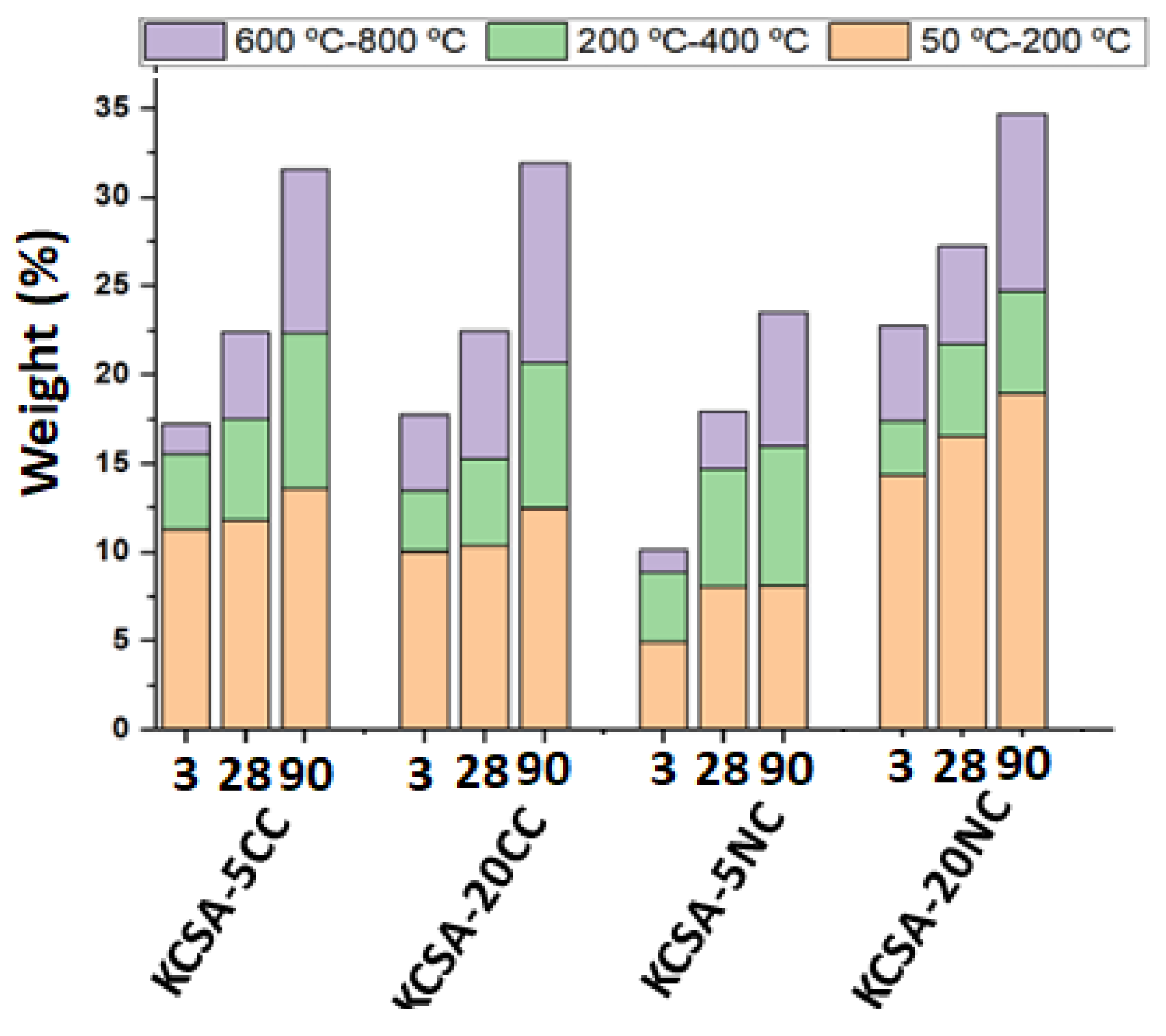


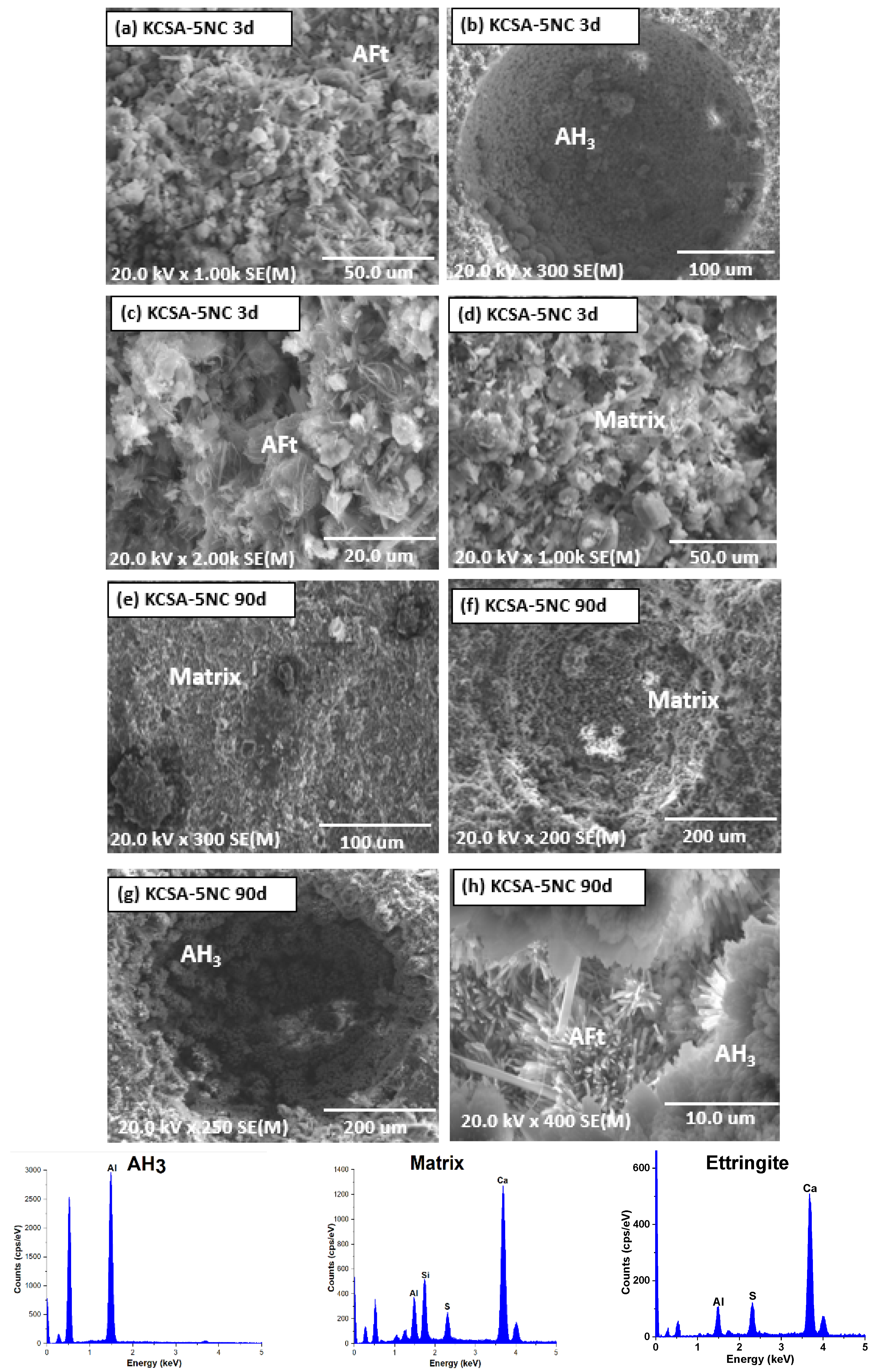
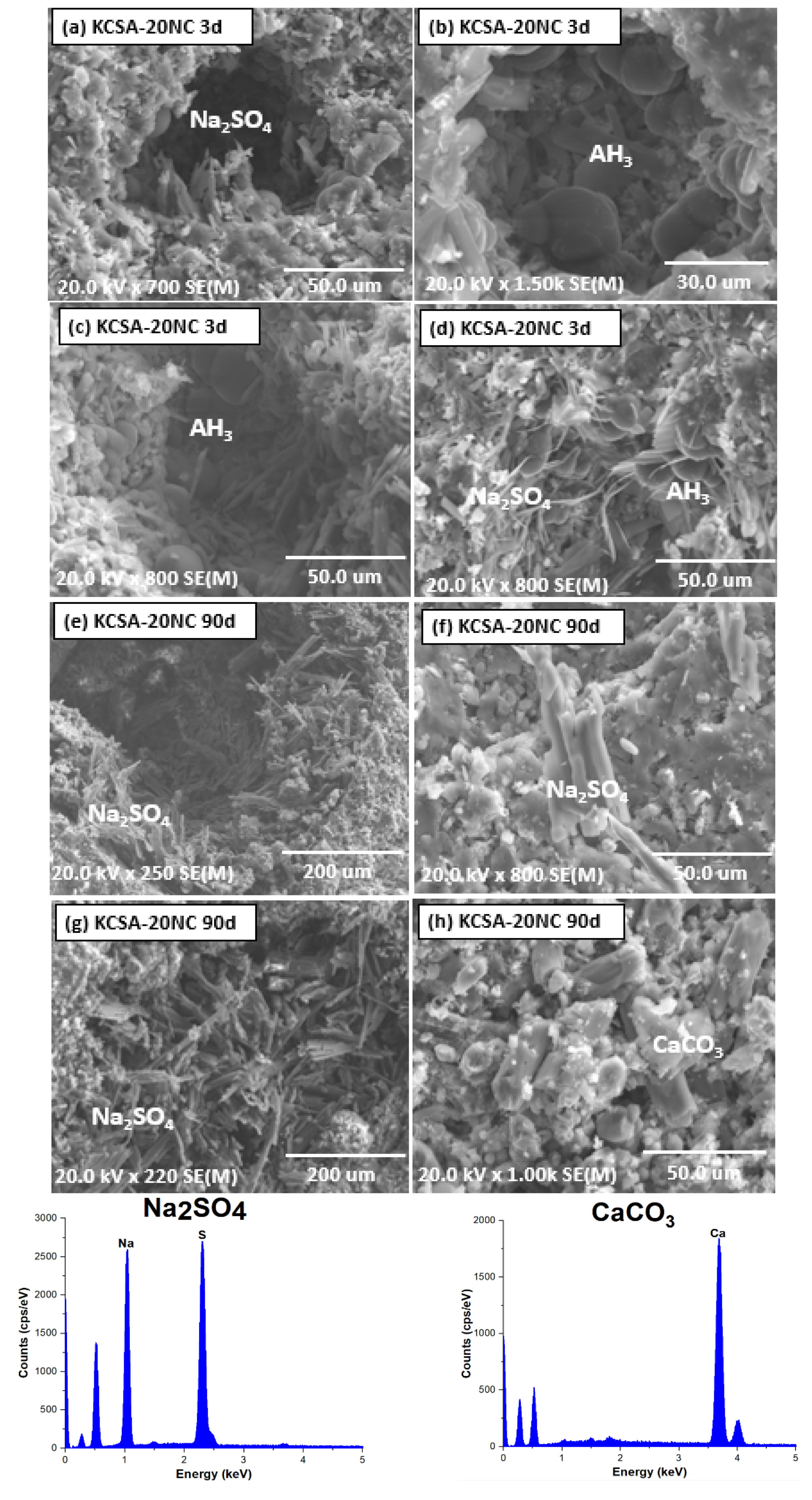
Disclaimer/Publisher’s Note: The statements, opinions and data contained in all publications are solely those of the individual author(s) and contributor(s) and not of MDPI and/or the editor(s). MDPI and/or the editor(s) disclaim responsibility for any injury to people or property resulting from any ideas, methods, instructions or products referred to in the content. |
© 2025 by the authors. Licensee MDPI, Basel, Switzerland. This article is an open access article distributed under the terms and conditions of the Creative Commons Attribution (CC BY) license (https://creativecommons.org/licenses/by/4.0/).
Share and Cite
Padilla-Encinas, P.; Fernández-Jiménez, A. Calcium or Sodium Carbonate Influence on Calcium Sulfoaluminate Clinker Hydration. Molecules 2025, 30, 2759. https://doi.org/10.3390/molecules30132759
Padilla-Encinas P, Fernández-Jiménez A. Calcium or Sodium Carbonate Influence on Calcium Sulfoaluminate Clinker Hydration. Molecules. 2025; 30(13):2759. https://doi.org/10.3390/molecules30132759
Chicago/Turabian StylePadilla-Encinas, Pilar, and Ana Fernández-Jiménez. 2025. "Calcium or Sodium Carbonate Influence on Calcium Sulfoaluminate Clinker Hydration" Molecules 30, no. 13: 2759. https://doi.org/10.3390/molecules30132759
APA StylePadilla-Encinas, P., & Fernández-Jiménez, A. (2025). Calcium or Sodium Carbonate Influence on Calcium Sulfoaluminate Clinker Hydration. Molecules, 30(13), 2759. https://doi.org/10.3390/molecules30132759





